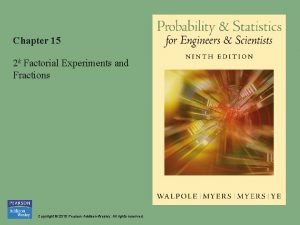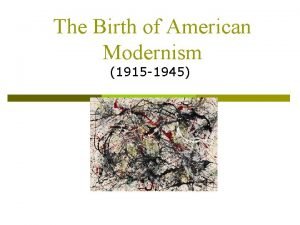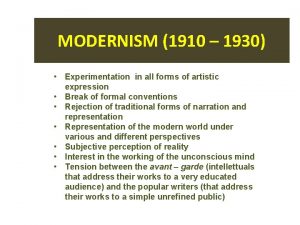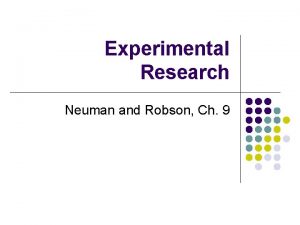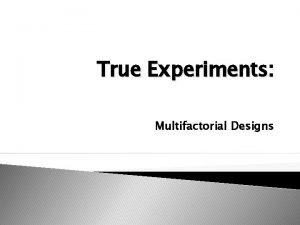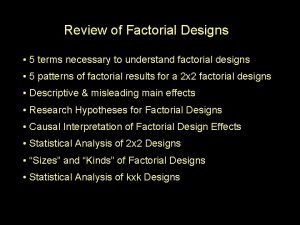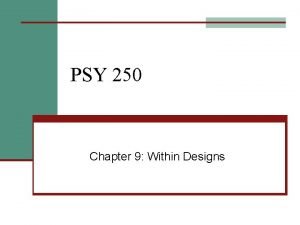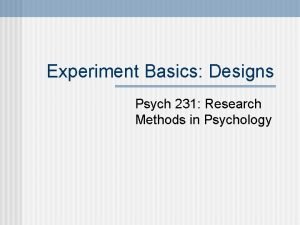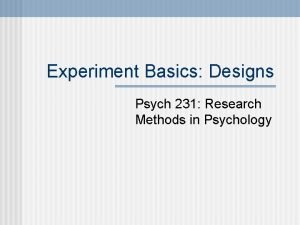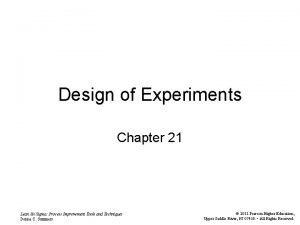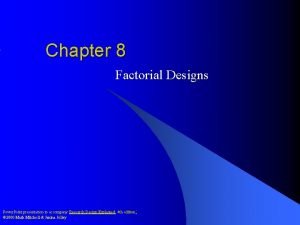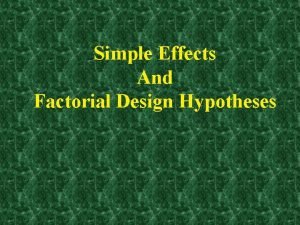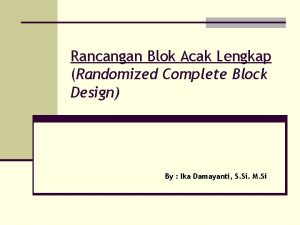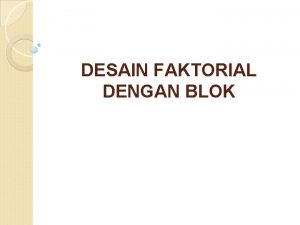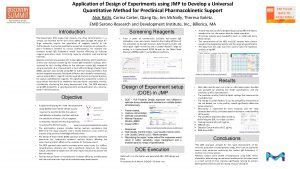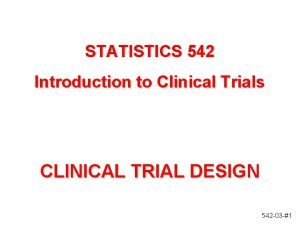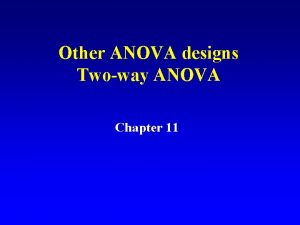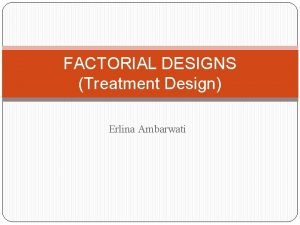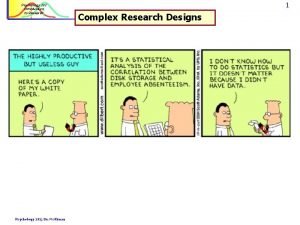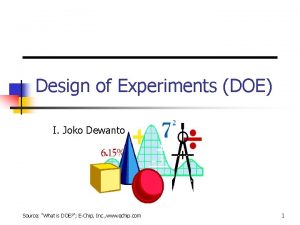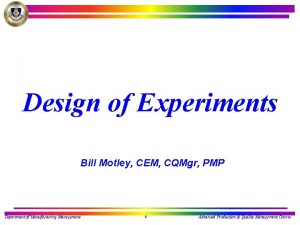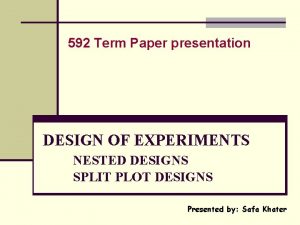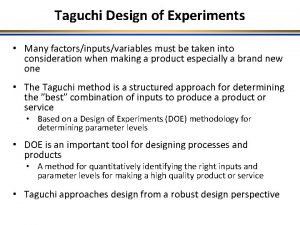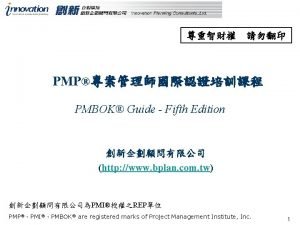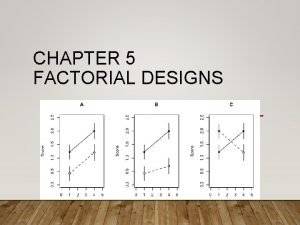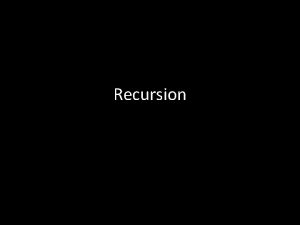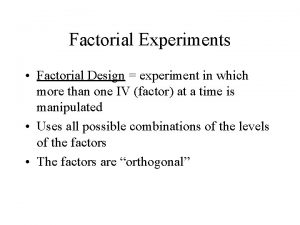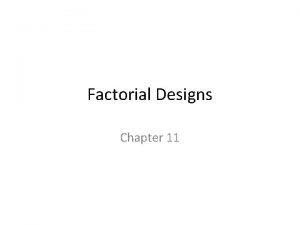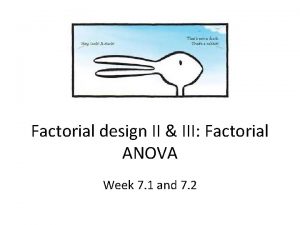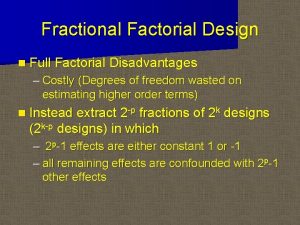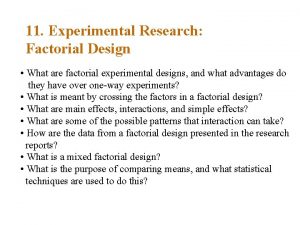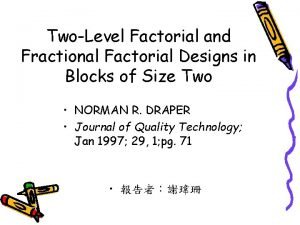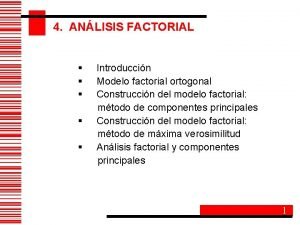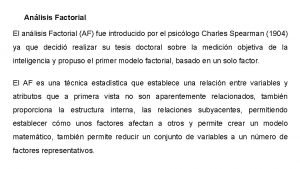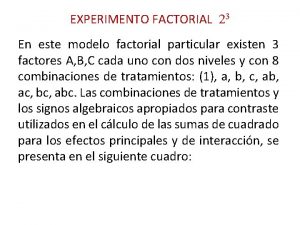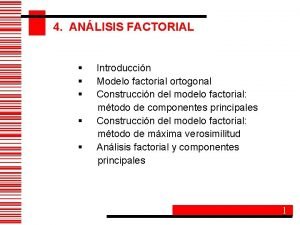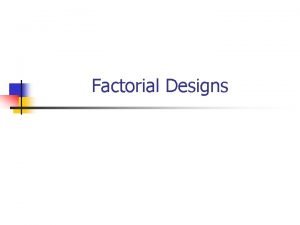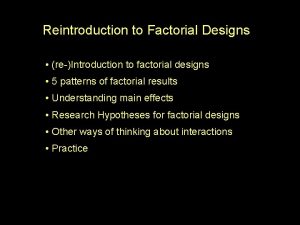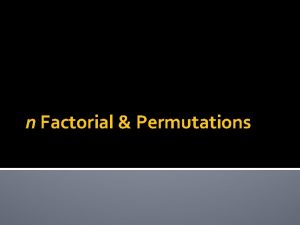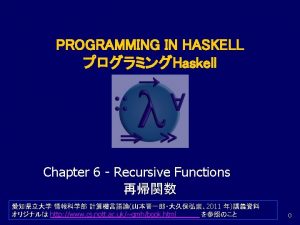Statistical Design of Experiments SECTION IV FACTORIAL EXPERIMENTATION

































- Slides: 33

Statistical Design of Experiments SECTION IV FACTORIAL EXPERIMENTATION Dr. Gary Blau, Sean Han Monday, Aug 13, 2007

FULL FACTORIAL EXPERIMENT Definition A set of experimental runs such that all levels of a given factor are combined with all levels of every other factor. Dr. Gary Blau, Sean Han Monday, Aug 13, 2007

TWO FACTORS A two level full factorial experiment in 2 factors consists of four runs: (low, low) (low, high) (high, low) Dr. Gary Blau, Sean Han Monday, Aug 13, 2007

EXAMPLE OF A TWO FACTORIAL EXPERIMENT Design a full factorial experiment in a tablet press to study the effect of Pressure (P) and Punch Distance (D) on the percent dissolution of tablets after 45 minutes. Factors Pressure (P) Punch Distance (D) Experimental runs 1 2 3 4 Dr. Gary Blau, Sean Han Level. 5 Ton - 1 Ton 1 mm - 2 mm P(ton). 5 1 D(mm) 1 1 2 2 Monday, Aug 13, 2007

GEOMETRIC REPRESENTATION (. 5, 2) (1, 2) (high) Punch Distance (low) (. 5, 1) (1, 1) (low) (high) Pressure Dr. Gary Blau, Sean Han Monday, Aug 13, 2007

CODING • In order to normalize the data and eliminate unit confusion, it is common practice to code the levels • Coding Values: Coded value = (original value – mean) /(range/2) • Example: To code the original values of Pressure: low coded value=(. 5 -. 75)/(. 5/2) = -1 or – high coded value=(1 -. 75)/(. 5/2) =1 or + Dr. Gary Blau, Sean Han Monday, Aug 13, 2007

TREATMENT COMBINATION A convenient approach to identify levels of a factor is to use an algebraic letter when the factor is at its high level. If all the levels in a treatment are low, we denote it by (1). A (-1, (+1, Dr. Gary Blau, Sean Han B -1) +1) = (1) = a = b = ab Monday, Aug 13, 2007

GENERAL ALGEBRAIC / GEOMETRIC REPRESENTATION For Two Factor A and B Experiment: Dr. Gary Blau, Sean Han Monday, Aug 13, 2007

FACTORIAL EXPERIMENTS WITH THREE FACTORS A two level full factorial experiment in three factors A, B and C consists of eight experiments: Level (low, low) (high, low) (low, high, low) (high, low) (low, high) (high, low, high) (low, high) (high, high) Dr. Gary Blau, Sean Han Coding Treatment Comb. (-1, -1) (+1, -1) a (-1, +1, -1) b (+1, -1) ab (-1, +1) c (+1, -1, +1) ac (-1, +1) bc (+1, +1) abc Monday, Aug 13, 2007

GEOMETRIC REPRESENTATION Three Factor Experiment Dr. Gary Blau, Sean Han Monday, Aug 13, 2007

THREE FACTOR EXAMPLE Design a full factorial experiment in a Tablet Press to study the effect of Pressure(P), Punch Distance(D) and API/Binder Ratio(R) on the percent dissolution of tablets after 45 minutes Dr. Gary Blau, Sean Han Monday, Aug 13, 2007

THREE FACTOR EXAMPLE Factors Pressure (P) Punch Distance (D) API/Binder Ratio (R) Experimental runs 1 2 3 4 5 6 7 8 Dr. Gary Blau, Sean Han Level. 5 ton - 1 ton 1 mm - 2 mm. 05 -. 15 Pressure(P) Distance(D). 5 1 1 1. 5 2 1 2 Ratio(R). 05. 05. 15. 15 Monday, Aug 13, 2007

THREE FACTOR EXAMPLE • Geometric Representation • Associated mathematical model Y = D + P + R + error Dr. Gary Blau, Sean Han Monday, Aug 13, 2007

NOTATION Original Exp Press Dist Ratio 1. 5 1. 05 2 1 1. 05 3. 5 2. 05 4 1 2. 05 5. 5 1. 15 6 1 1. 15 7. 5 2. 15 8 1 2. 15 Dr. Gary Blau, Sean Han Coded ( +, -) P D R (A) (B) (C) + + + Treatment Combination (1) a b ab c ac bc abc Monday, Aug 13, 2007

CALCULATING MAIN EFFECTS Main Effect of a factor – is the change in response produced by the change in the level of a factor. When a factor is examined at two levels only, the main effect of the factor is the average of the differences of the responses between the high level and the low level of the factor. Dr. Gary Blau, Sean Han Monday, Aug 13, 2007

EXAMPLE FOR CALCULATING MAIN EFFECTS Example 1: In two factors: Treatment Combination (1) a b ab Dr. Gary Blau, Sean Han (P) + + (D) + + %Dissolution 61 86 76 86 Monday, Aug 13, 2007

EXAMPLE FOR CALCULATING MAIN EFFECTS • There are two measurements of the main effect of A: (response at high value of A) – (response at low value of A) Dissolution(a) Dissolution(1) 86 61 = 25 Dissolution(ab) Dissolution(b) 86 76 = 10 • The overall main effect is an average of these differences: (25+10)/2=17. 5 • Similarly, the main effect of B: ((76 -61)+(86 -86))/2=7. 5 Dr. Gary Blau, Sean Han Monday, Aug 13, 2007

EXAMPLE FOR CALCULATING MAIN EFFECTS Example 2 - In three factors Treatment Combination (P) (D) (R) (1) a + b + ab + + c + ac + + bc + + abc + + + Dr. Gary Blau, Sean Han %Dissolution 61 86 76 86 56 83 74 95 Monday, Aug 13, 2007

EXAMPLE FOR CALCULATING MAIN EFFECTS • How many measurements exist for the main effect of A? 4 • What are they? Dr. Gary Blau, Sean Han a- (1) ab-b ac-c abc-bc Monday, Aug 13, 2007

EXAMPLE FOR CALCULATING MAIN EFFECTS Main effects of A Dr. Gary Blau, Sean Han Monday, Aug 13, 2007

INTERACTION AB Interaction is the difference between the main effect of A at the high level of B and the main effect of A at the low level of B. Dr. Gary Blau, Sean Han Monday, Aug 13, 2007

TYPE OF INTERACTION No Interaction Negative Interaction Strong Negative Interaction Positive Interaction Dr. Gary Blau, Sean Han Monday, Aug 13, 2007

CALCULATING SIGNS To calculate the sign of the interaction, simply multiply the signs of the factors in the interaction. e. g. AB for A(+), B(-) is: (+) * (-) = (-) Dr. Gary Blau, Sean Han Monday, Aug 13, 2007

SIGNS COMPUTING TABLE Dr. Gary Blau, Sean Han Monday, Aug 13, 2007

MODELS Dr. Gary Blau, Sean Han Monday, Aug 13, 2007

NUMBER OF INTERACTIONS For Factors at Two Levels: Dr. Gary Blau, Sean Han Monday, Aug 13, 2007

EXAMPLE FOR INTERACTION IN THREE FACTOR EXPERIMENT Dr. Gary Blau, Sean Han Monday, Aug 13, 2007

EXAMPLE FOR INTERACTION IN THREE FACTOR EXPERIMENT • Calculate the AB interaction in three factors example: Dr. Gary Blau, Sean Han Monday, Aug 13, 2007

CHOICE OF LEVELS • The choice of levels has considerable impact on the chances of detecting important effects • If the range of levels is not wide enough, the important effects will not be detected!! • Determine the smallest change in the levels of the factors that produces a noticeable change in the response • Space the levels as far apart as reasonable to improve detection and estimation of effects Dr. Gary Blau, Sean Han Monday, Aug 13, 2007

REPLICATION • Without a message of reproducibility, the significance of the effects cannot be evaluated. This message can come from replicated points, previous measures, or “hidden” measures in the data • The single most efficient replication point is usually the “center point” of the experimental region • Complete replication of the design improves the chances of detecting an effect Dr. Gary Blau, Sean Han Monday, Aug 13, 2007

RANDOMIZATION AND BLOCKING • In order to reduce the effect of the experimental order, the selection of the experimental runs should be randomized. • The center points should be randomized and evenly distributed throughout • Where appropriate, blocking may be used to improve sensitivity, i. e. , blocking removes a source of variation from the total error. Dr. Gary Blau, Sean Han Monday, Aug 13, 2007

EXAMPLE FOR RANDOMIZATION Dr. Gary Blau, Sean Han Monday, Aug 13, 2007

SUMMARY • Enable the main effects of every factor to be estimated independently of one another • Enable the dependence of the effect of every factor upon the levels of the others (interaction) to be determined • Supply an estimate of experimental error for the purpose of assessing the significance of effects and enable confidence limits to be determined Dr. Gary Blau, Sean Han Monday, Aug 13, 2007
 2k factorial experiments and fractions
2k factorial experiments and fractions Modernism and experimentation in american literature
Modernism and experimentation in american literature Active experimentation
Active experimentation Modernism and experimentation
Modernism and experimentation Types of sae programs
Types of sae programs Experimentation in modernism
Experimentation in modernism Example of experimentation
Example of experimentation Matthew robson
Matthew robson Nuremberg code
Nuremberg code Traditional poetry vs modern poetry
Traditional poetry vs modern poetry Expericorr design
Expericorr design 2x2 factorial design
2x2 factorial design Within subject design vs between subject design
Within subject design vs between subject design Within-subject design example
Within-subject design example Within-subjects design
Within-subjects design What is between and within subjects design
What is between and within subjects design Design of experiments six sigma
Design of experiments six sigma Desain faktorial 2x3
Desain faktorial 2x3 Factorial design ppt
Factorial design ppt Three way factorial design
Three way factorial design Simple effect in factorial design
Simple effect in factorial design Randomized complete block design adalah
Randomized complete block design adalah Factorial randomized block design
Factorial randomized block design Doe in jmp
Doe in jmp Triple blind study
Triple blind study Anova table
Anova table Contoh factorial design
Contoh factorial design 2 kp
2 kp Disinhibition
Disinhibition Design of experiments doe
Design of experiments doe Design of experiments pmp example
Design of experiments pmp example Design of experiments presentation
Design of experiments presentation Taguchi design of experiments
Taguchi design of experiments Design of experiments pmp
Design of experiments pmp
